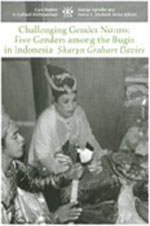|
Tag
|
Ind1
|
Ind2
|
Isi
|
|
001
|
|
|
INLIS000000000002855
|
|
005
|
|
|
20221017092806
|
|
008
|
|
|
221017################|##########|#eng##
|
|
020
|
#
|
#
|
$a 0495092800
|
|
035
|
#
|
#
|
$a 0010-0520002855
|
|
041
|
|
|
$a eng
|
|
082
|
#
|
#
|
$a 305.89922
|
|
084
|
#
|
#
|
$a 305.89922 DAV c
|
|
100
|
0
|
#
|
$a Davies, Sharyn Graham
|
|
245
|
1
|
#
|
$a Challenging Gender Norms : Five Genders Among Bugis in Indonesia /$c Sharyn Graham Davies
|
|
250
|
#
|
#
|
$a 2nd ed.
|
|
260
|
#
|
#
|
$a Australia :$b Routledge,$c 2007
|
|
300
|
#
|
#
|
$a xii, 175p. : $b : illus. ; $c 24 cm.
|
|
500
|
#
|
#
|
$a Indeks : p.169-175
|
|
520
|
#
|
#
|
$a This ethnography explores a society that recognizes not just two gender categories, like most societies. The topic of this book reveals another fascinating aspect of Bugis culture : gender multiplicity. The Bugis language, Basa Ugi, has five terms to describe an individual's gender identity: makkunrai (feminine woman), oroane (masculine man), calalai (masculine female), calabai (feminine male), and bissu (transgender shaman). These translations are very cursory and by no means reveal the depth of these subjectivities; it will take this book and more to explore the real richness of these multiple gender identities. In this case study, an anthropologist explores the rich gender diversity among Bugis, the largest ethnic group in South Sulawesi, Indonesia.
|
|
650
|
|
4
|
$a Bugis, Indonesia - Ethnic identity
|
|
650
|
|
4
|
$a Ethnology - Bugis
|
|
650
|
|
4
|
$a Sociology - Bugis
|
|
990
|
#
|
#
|
$a 10791/MKRI-P/XI-2008
|
|
990
|
#
|
#
|
$a 10791/MKRI-P/XI-2008
|
|
990
|
#
|
#
|
$a 10791/MKRI-P/XI-2008
|
|
990
|
#
|
#
|
$a 10792/MKRI-P/XI-2008
|
|
990
|
#
|
#
|
$a 10792/MKRI-P/XI-2008
|
|
990
|
#
|
#
|
$a 10792/MKRI-P/XI-2008
|
